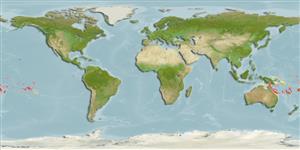>
Blenniiformes (Blennies) >
Tripterygiidae (Triplefin blennies) > Tripterygiinae
Etymology: Enneapterygius: Greek, ennea = nine times + Greek, pterygion = little fin (Ref. 45335).
More on author: Fricke.
Environment: milieu / climate zone / depth range / distribution range
Écologie
marin récifal; profondeur 0 - 17 m (Ref. 13227). Tropical
Southwest Pacific: Australia, Vanuatu, Fiji, then east to American Samoa, and the French Polynesia.
Taille / Poids / Âge
Maturity: Lm ? range ? - ? cm
Max length : 4.5 cm SL mâle / non sexé; (Ref. 54980)
Description synthétique
Clés d'identification | Morphologie | Morphométrie
Épines dorsales (Total) : 14 - 17; Rayons mous dorsaux (Total) : 7 - 11; Épines anales: 1; Rayons mous anaux: 17 - 21. Small and slender supraorbital tentacle; in males, first spine of first dorsal fin higher than first spine of second dorsal fin; in females, first dorsal fin a little less than 50% shorter than second dorsal fin; females whitish, with fine black dots, bearing a reticular red or brown pattern, isolating the white into 2-3 longitudinal rows of blotches; male coloration similar but generally darker. Dorsal rays III + XI-XIII + 7-10; lateral line interrupted, 14-20 + 14-21; mandibular pores 3-4 + 1 + 3-4 (Ref. 54980).
Female members of the Tripterygiidae have eggs that are hemispherical and covered with numerous sticky threads that anchor them in the algae on the nesting sites (Ref. 240). Larvae are planktonic which occur primarily in shallow, nearshore waters (Ref. 94114).
Life cycle and mating behavior
Maturities | Reproduction | Spawnings | Egg(s) | Fecundities | Larves
Fricke, R., 1994. Tripterygiid fishes of Australia, New Zealand and the southwest Pacific Ocean (Teleostei). Theses Zool. 24:1-585. (Ref. 13227)
Statut dans la liste rouge de l'IUCN (Ref. 130435)
Menace pour l'homme
Harmless
Utilisations par l'homme
Pêcheries: sans intérêt
Outils
Articles particuliers
Télécharger en XML
Sources Internet
Estimates based on models
Preferred temperature (Ref.
123201): 25 - 29, mean 27.1 °C (based on 457 cells).
Phylogenetic diversity index (Ref.
82804): PD
50 = 0.5000 [Uniqueness, from 0.5 = low to 2.0 = high].
Bayesian length-weight: a=0.00562 (0.00258 - 0.01228), b=3.08 (2.89 - 3.27), in cm total length, based on LWR estimates for this (Sub)family-body shape (Ref.
93245).
Niveau trophique (Ref.
69278): 3.2 ±0.3 se; based on size and trophs of closest relatives
Résilience (Ref.
120179): Haut, temps minimum de doublement de population inférieur à 15 mois (Preliminary K or Fecundity.).
Fishing Vulnerability (Ref.
59153): Low vulnerability (10 of 100).
Nutrients (Ref.
124155): Calcium = 371 [165, 1,059] mg/100g; Iron = 1.83 [0.77, 3.67] mg/100g; Protein = 18.3 [16.8, 19.8] %; Omega3 = 0.102 [0.036, 0.307] g/100g; Selenium = 47 [13, 150] μg/100g; VitaminA = 56 [11, 275] μg/100g; Zinc = 4.02 [2.07, 6.83] mg/100g (wet weight);
